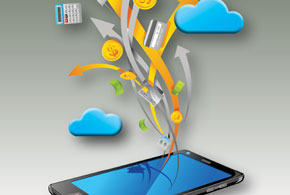One of the top tourist attractions in Canada is the CN Tower, which is 553.33 meters (1, 815 ft., 5 in.) tall. It opened in 1976 as a communications towers, and to reflect that role in today’s digital age, it planned on celebrating its 40th anniversary with a new wireless infrastructure and the CN Tower app.
Kevin McManus, director of IT for the CN Tower, says management realized that given the extent of digitization in the world, it needed to engage visitors via their smartphone. The new wireless system was designed to meet the requirements of today’s visitors. “These days, you’ve got to supply free WiFi, and free WiFi leads to extended time on the property,” he points out.
Through research, the organization discovered that 83 percent of Canadians own a smartphone, and that among the visitors, at least one person in each group comes in with a smart device—most likely an iPhone or Android smartphone. It also learned that people are more amenable to downloading an app if it’s free, easy to download and can be removed from the device, if desired.
Delivering Information and Engaging With Visitors
Bearing that in mind, the organization planned a system that could use the smart device both as a source of information and as a tool for engagement with visitors.
The CN Tower uses Aruba Gigabit wireless infrastructure, including Aruba AirWave for network management and Aruba ClearPass Policy Manager to help onboard mobile devices and provide secure guest access for visitors and guests. It also uses Aruba’s Mobile Engagement solution, which is based on a software platform and Bluetooth Low Energy (BLE) beacons that deliver the location services capabilities. Aruba partner Access 2 Networks (A2N) provided assistance.
There are more than 150 beacons in and around the building to identify locations and send relevant notifications to visitors based on their proximity beacon.
Lisa Tompkins, director of sales, marketing and communications for the CN Tower, explains that they worked in stages. The first phase for the app’s launch was to enable wayfinding with beacons. The app can direct visitors to get from their current location to where they want to be. They can log onto maps to get answers to questions such as, “How can I get to the glass floor?” or “Where’s the closest washroom?”
The second phase was to engage with guests by offering suggestions, such as recommending a particular restaurant or an attraction like Edgewalk. The plan is to roll out additional engagement ideas in the future—possibly some that don’t only notify a visitor, but also offer a specific motivation. For example, one idea might be to display something a visitor could find in the gift shop.
The data gathered from the push notifications tells the organization how many times of day—and at what times during the day—notifications are triggered. McManus explains that with 60 WiFi access points collecting data 24 hours a day, they get very good statistics about the number of people passing through an area and the amount of time they spend in that area. That gives the organization insight into dwell times and wait times for the elevators and for accessing specific areas.
Management can then respond, perhaps by adding staff where needed. It also can better inform visitors about what to expect, when an area is busiest with the longest waits, and when they can breeze through on shorter lines. “The more information we have like that, the more we can share it,” Tompkins says.
The building’s managers can also use that information to build a marketing strategy to promote more effective engagement, cross-selling and recommendations, etc. That strategy even extends beyond the walls of the tower: Data streaming in from people passing by outside can be used to encourage people to visit. That high-tech signaling is supplemented by low-tech visuals like signs advertising the app.
In that way, the physical and digital worlds come together. The project also brought together the two worlds with a collaborative and strategic solution for gathering data, running analytics on that data and then building a program around it.









